The Self-Driving Car (Parts) That You Can Buy Already Now
There is nothing more boring than driving a car from A to B. You are a slave to the machine, and have no chance to do something else - even listening to an audio book can be risky if you are as multi-tasking challenged as the author of this post.

And while the only way to get a half-way working self-driving car for your daily commute is to work for Google X, the good news is that money can buy you certain parts already: This post gives an overview of the type of autonomous car technology that is available for sale already.
The elements we discuss include road sign recognition, collision avoidance system, adaptive cruise control, lane departure warning, navigation system and the automatic parking assistant. These are systems either act as sensor/input data for future decisions making algorithms (e. g. road sign recognition) or already do a sub-task autonomously (e. g. parking assist).
Road Sign Recognition
Drivers should always be aware of the current speed limit. With Road Sign Recognition (Verkehrszeichenerkennung) currently applicable road signs are in view. So these system enhance the static information provided by your navigation system with current information (e. g. temporary speed limits near a construction site).
When a video camera identifies a road sign signaling the beginning or end of a speed limit as well as any special instructions, such as “when wet”, the function displays this sign in the form of a symbol in the cockpit.
Currently available system are limited to recognizing speed limits and – some – the “do not overtake” signs. Speed limit road sign detection is a solved problem for countries/areas/roads where the signs follow strict norms. The German ADAC (General German Automobile Association) did a first test of available systems already in 2011.
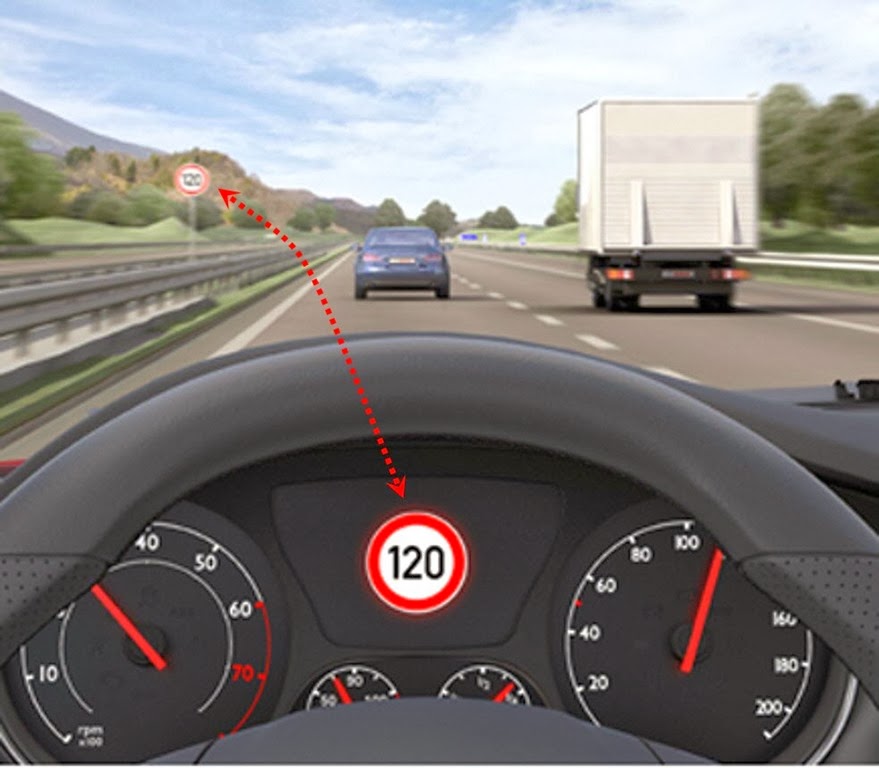
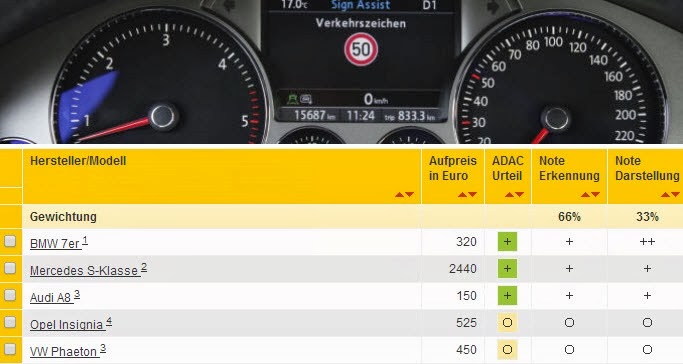
Collision avoidance system
A collision avoidance system (Notbremssystem) is, according to Wikipedia, an automobile safety system designed to reduce the severity of an accident. Also known as precrash system, forward collision warning system or collision mitigating system, it uses radar and sometimes laser and camera sensors to detect an imminent crash. Once the detection is done, these systems either provide a warning to the driver when there is an imminent collision or take action autonomously without any driver input (by braking or steering or both)
a collision avoidance system is a huge step forward as here “the machine” takes over in a potentially live threatening situation (to the driver or to whoever is in front of the car).
Current system can detect cars, bikes and also pedestrians, warn the driver, and if she does not react, break the car automatically. No available system can actually steer around an obstacle yet, available system only alert to user and, if she does not react, break the car.
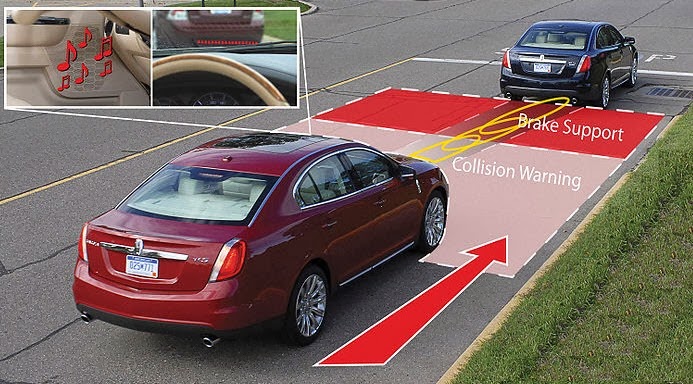
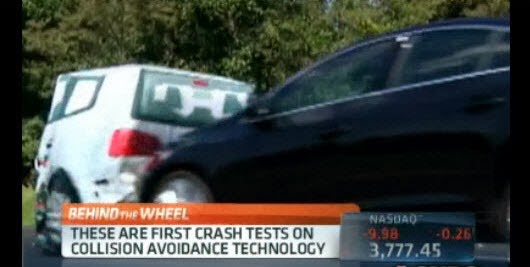
As a side note, no system in the market can distinguish a soft, plastic “mockup” car (as used in this test) from a real car.
Another available collision avoidance system flavor is the Rear Cross Traffic Alert (Querverkehrswarnung).
Adaptive Cruise Control
Autonomous cruise control (also called adaptive or radar cruise control, Abstandsregeltempomat) is an optional cruise control system that automatically adjusts the vehicle speed to maintain a safe distance from vehicles ahead. It makes no use of satellite or roadside infrastructures nor of any cooperative support from other vehicles. Hence control is imposed based on sensor information from on-board sensors only.
Based on the information of a radar sensor ACC registers the situation in front of the vehicle. If the driver approaches a preceding vehicle, ACC slightly decelerates to ensure that the defined minimum distance to the preceding vehicle is maintained. This distance can be adapted to individual driving behavior. Once the lane is clear again, ACC accelerates to previous set speed selected by the driver.
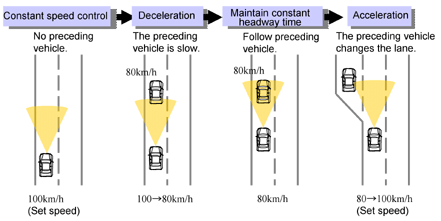
Lane Departure Warning
Lane Departure Warning (Spurverlassenswarnung) and his bigger brother, the Heading Control Assist (Spurhalteassistent) make sure you stay on track. Whereas ACC takes over the gas pedal, the Heading Control Assist takes over the steering wheel. However, no Heading Control Assist is available today. Available system provide a lane departure warning – i. e. they warn the driver if she is about the depart from a lane, may vibrate the wheel, but it is up to the driver to bring back the car into the lane. So no eating while driving just yet.

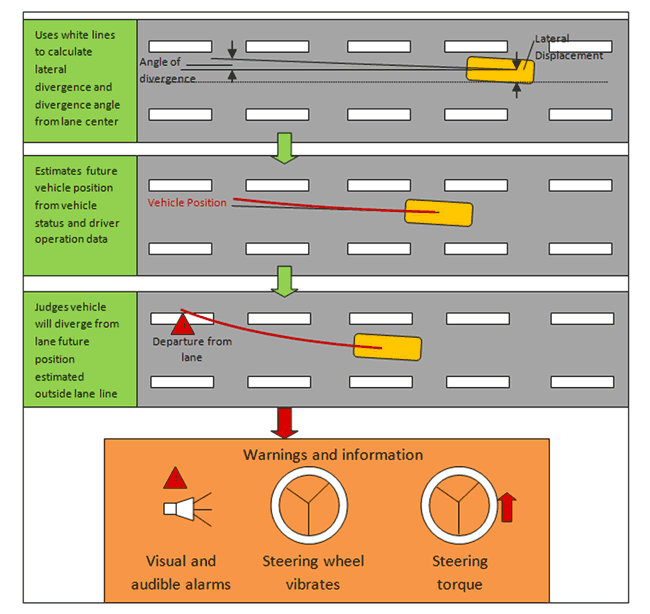
Lane Departure Warning schematics (source)
Navigation System
We all know this one already. But the list would not be complete without it! And clearly, without GPS satellites there would be no chance for a self-driving car in this decade. No research group is working on GPS less navigation (e. g. by reading road sign - way too difficult, especially as we have a good solution with GPS). As an interesting side note, we also see the shift in consumer perception here. At the beginning, GPS devices were only for those who are “unable to read the map” or have “no sense of orientation” – now it is a device that even the best scouts among us do not want to miss in their daily live.
Automatic parking assistant
Reached your destination? Then the Automatic parking assistant (Einparkassistent) will come in handy. The Automatic parking assistant is, according to Wikipedia, an autonomous car maneuvering from a traffic lane into a parking place to perform parallel parking, perpendicular or angle parking. The automatic parking aims to enhance the comfort and safety of driving in constrained environments where much attention and experience is required to steer the car.
(And just like navigation, it can also help to save marriages.)
A good 2013 example of a state-of-the-art parking assistance is the Skoda/VW system:

To quote Skoda: “The Automatic Parking Assistant lets you experience the next generation of parking systems that bring a new level of comfort and convenience to your everyday driving.When you need to park your car in a row of stationary cars that are parked lengthwise or crosswise, the car will help you to locate a suitable parking space as you drive along.In order to parallel park your car, you only need to locate a parking spot with just 30cm in front of your car and 30cm behind it. Afterwards, the Automatic Parking Assistant will effortlessly park the vehicle without any additional input from the driver.”
Technically these system work as follows:A special ultrasonic sensor mounted on the side of the bumper scans the side of the street as the vehicle is moving. The parking assistant calculates the best possible way to move into the parking space, and determines which steering actions are necessary. The driver can then let go of the steering wheel, and let the parking assistant take over. The driver controls the parking process through carefully pressing the gas and brake pedals.
Obviously, the system also supports while parking out. It helps the driver to bring the vehicle in the correct starting position, by taking over all steering maneuvers to drive out of the parking space safely .
Stuff that will go away
There are some interesting technologies that are helpful today but that did not make the cut into this list. These are technologies that deal directly with the shortcomings of a human driver and will not be needed in a future self-driving car.
- Driver drowsiness detection - kind of like a train’s dead man switch.
- Intelligent Headlight Control and Night Vision Plus - Helpful for the human eye, but fog and darkness make no difference for a LIDAR sensor.
- Rear view assist and side view assist. This is a workaround for the lack of a 360° degree human eyesight. If frogs could drive cars, they would not need it.
Did I miss anything in this list? Please let me know in the comments.